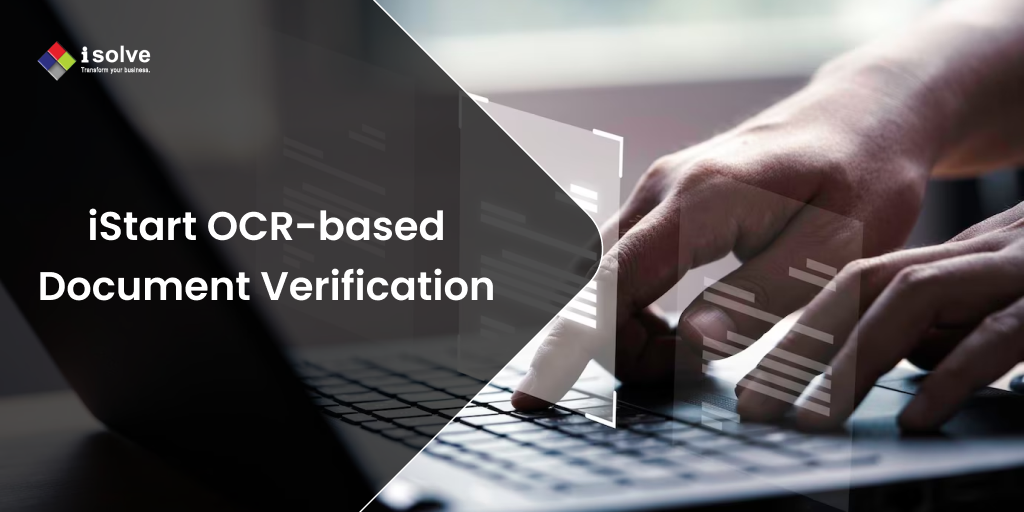iFlow CKYC: A Single Window Platform to Offer One Time KYC …
OCR-based Document Verification for Digital Customer Onboarding Process
Authored by: Mohammed Mansoor Reading Time: 03 min 30 sec
Authored by: Mohammed Mansoor Reading Time: 03 min 30 sec
Financial institutions like banks are tasked with processing millions of customer documents yearly and digitizing their records for faster storage and retrieval.
Optical Character Recognition (OCR) is an emerging technology that helps extract data from pdf/images to convert paper-based documents and pdf documents to Excel, CSV, and other formats.
In this blog, let us learn how iStart’s OCR technology helps banks and NBFCs to increase business efficiency and make it easier to automate data capture from financial statements.

After scanning all of the pages in a document, OCR software converts it into a two-color, or black and white, form. In scanned-in images or bitmaps, dark areas indicate characters, while light areas indicate background. We examine these areas for light and dark regions.
After analyzing the dark areas, alphabetic or numerical digits are searched for. OCR algorithms use many strategies, but most focus on a single letter, phrase, or text block at a time. Character detection occurs using one of two algorithms:
OCR programs compare and recognize text samples in different fonts and formats.
OCR programs use rules based on a letter or number characteristics to recognize characters on scanned pages. Character characteristics may include angles, crossed lines, or curves.
A character is converted to an ASCII code that computers can use for other actions. Users should correct basic errors, proofread, and double-check intricate layouts before storing documents.
OCR is based on three main ideas: Pre-Processing, Character Identification, and Post-Processing.
OCR optimizes the scanned document or picture before Machine Learning algorithms begin to identify characters and text. This stage improves recognition accuracy by improving the picture, removing distortions, and removing faults.
The first step is to identify the data to be extracted. By rejecting unwanted information and extracting only important data, Feature Extraction is a process that transforms machine-readable data into machine-readable text.
This improves accuracy and corrects mistakes. Many OCR applications use lexicons to protect their output. In this case, the algorithm validates and cross-references bespoke phrases created for a particular industry.
OCR is a genuinely game-changing invention. OCR’s numerous uses and functions cannot be emphasized. OCR digitizes everything, from official papers like passports to license plate identification
The use of manual data entry and verification slows down onboarding and account opening, limiting your organization’s ability to attract new business. By disrupting the registration process, you risk disrupting the consumer sales cycle. OCR can automatically capture and extract personal information from any identity paper.
An OCR solution eliminates the need for manually copying and comparing personal information to documents. As a result, customer onboarding is faster, and staff and consumers are happier. The document can be scanned, the data saved, and the verification process completed in seconds.
With iStart’s Document Verification API-based platform, you can effectively onboard users and verify their identities with CERSAI. By using AI-enabled OCR, document verification now helps with the following:
A simple verification solution is essential for companies. By utilizing iStart’s OCR technology, verification time is significantly reduced, and direct input from the end user is eliminated, which can prove tiring since nobody enjoys filling out lengthy forms. Scan a photo of the consumer’s national identification card; they are ready to go!
Get an AI-enhanced OCR solution for document and ID verification with iStart!
iFlow CKYC: A Single Window Platform to Offer One Time KYC …
Importance of data privacy in Aadhaar Authentication: How iStart can help? Authored …
OCR-based Document Verification for Digital Customer Onboarding Process Authored by: Mohammed Mansoor …
+91 93634 99313 | +91 89398 11425 | +91 93634 99328
competence_building@isolve.co.in | talentsourcing@isolve.co.in
+91 99940 56227 | +91 78258 78258
business@isolve.global
Middle East
A4 - 105A, Building No. A4
Al Hamra Industrial Zone-FZ
RAK, United Arab Emirates
M: +971 - 5238 66435
Netherlands
Strawinskylaan 3051, 1077ZX, Amsterdam,
The Netherlands.
M: +31 6495 62630
Norway
C. J. Hambros plass 2c,
0164 Oslo,
Norway.
M: +47 92 96 06 81
